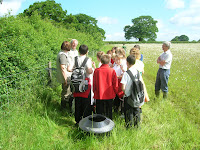The Kingfisher Project.
Introduction
The Kingfisher Award Scheme was set up here in Somerset by Michael Brown in 2008.
Its objective is to make children aware of the relationship between wildlife and farming; to look at habitats in detail and to inspire them generally with a life long interest in the country. The Scheme was launched in Devon in 1992, the idea of poet laureate Ted Hughes and friends, and has been running very successfully there ever since. It is affiliated to FWAG – Farming and Wildlife Advisory Group – but not supported financially by them and entirely self funded.
This is its first year of operation in Somerset.
Though nearly all specialist help is voluntary, the cost of running Kingfisher is about £5,500 a year, with transport, specialist equipment, travel, food, prizes and insurance amongst the main outgoings. The Somerset branch of the charity has to stand entirely on its own and funds have been raised from a small number of donors, farmers and landowners and by running a marathon.
The Project was able to invite six local primary schools to farmland just south of Curry Rivel, in a stunning grass meadow displaying many old grass species and native wildflowers.
Each school were invited to send one class, usually 9-11 yr olds, and each had half a day on site. Learning in the open, and learning by discovery are the two main themes of the Kingfisher Award - and having fun too!
And it is more than just a farm visit for it has three distinct parts: the Field Trip; the Project; and the Presentation.
The Field Trip.
The field trip involves practical time on a farm site where children are introduced to a specific habitat, for example, hedge rows and field margins. This year in early June we based our presentations around the food chain. The children were able to see close up a real live barn owl and to learn how they hunted and what they ate by dissecting owl pellets (very popular!). They were able to look at the skulls of small mammals and follow this up by seeing how they can be studied by trapping voles, mice and shrews, to be released unharmed back in their habitat.
Butterfly Conservation volunteers were able to show some live specimens of local butterflies and moths and a local bee keeper provided an active hive, totally enclosed for safety.
The emphasis was given to hands on investigation, no note taking, and a high priority on having fun. The children learn in the company of specialists and volunteers, (most of whom are local), through discovery and because they were captivated by what they see.
The Project.
The second part follows on from the field visit when the children go back to the classroom and work together to research and create displays that reflect their experience in the field.
The Presentation.
Finally the children’s work was displayed and judged at a special Presentation day on July 15th, in a large old stone grain barn at Home Farm, Curry Rivel, near Langport. The experience for the children included prizes, a picnic, a storyteller and music.
The presentations were based on the field visits that took place in early June. It was clear that schools and their children had put a great deal of effort into their displays which even included poems and photo albums of the event.
The Judging.
And the judging! A panel of three judges were able to talk to the children about their work, carefully assess the displays and prizes were awarded to the runner up as well as winning school. First Prize receives a hand carved Kingfisher Trophy as well as a day in class with willow worker, Serena de la Haye. Serena is well known for her willow sculpture of the figure alongside the M5 near Bridgewater.
Summing Up
Each year a challenge trophy will be awarded to the winning school along with prizes and certificates. What is fascinating is the variety of work produced from a similar experience. Best of all is hearing from the children about their experience and the positive reaction of the teachers for whom it has been a wonderful way to teach the curriculum.
It was a huge success, the children were totally absorbed and the three days were as much enjoyed by adults as they were by the children. Such has been the success of the scheme that the aim next year is to broaden its scope and invite schools from towns as well as villages to take part.
This project description has been based on information supplied by Michael Brown and edited for this blog. Any errors should be sent to the Blog Ed!





